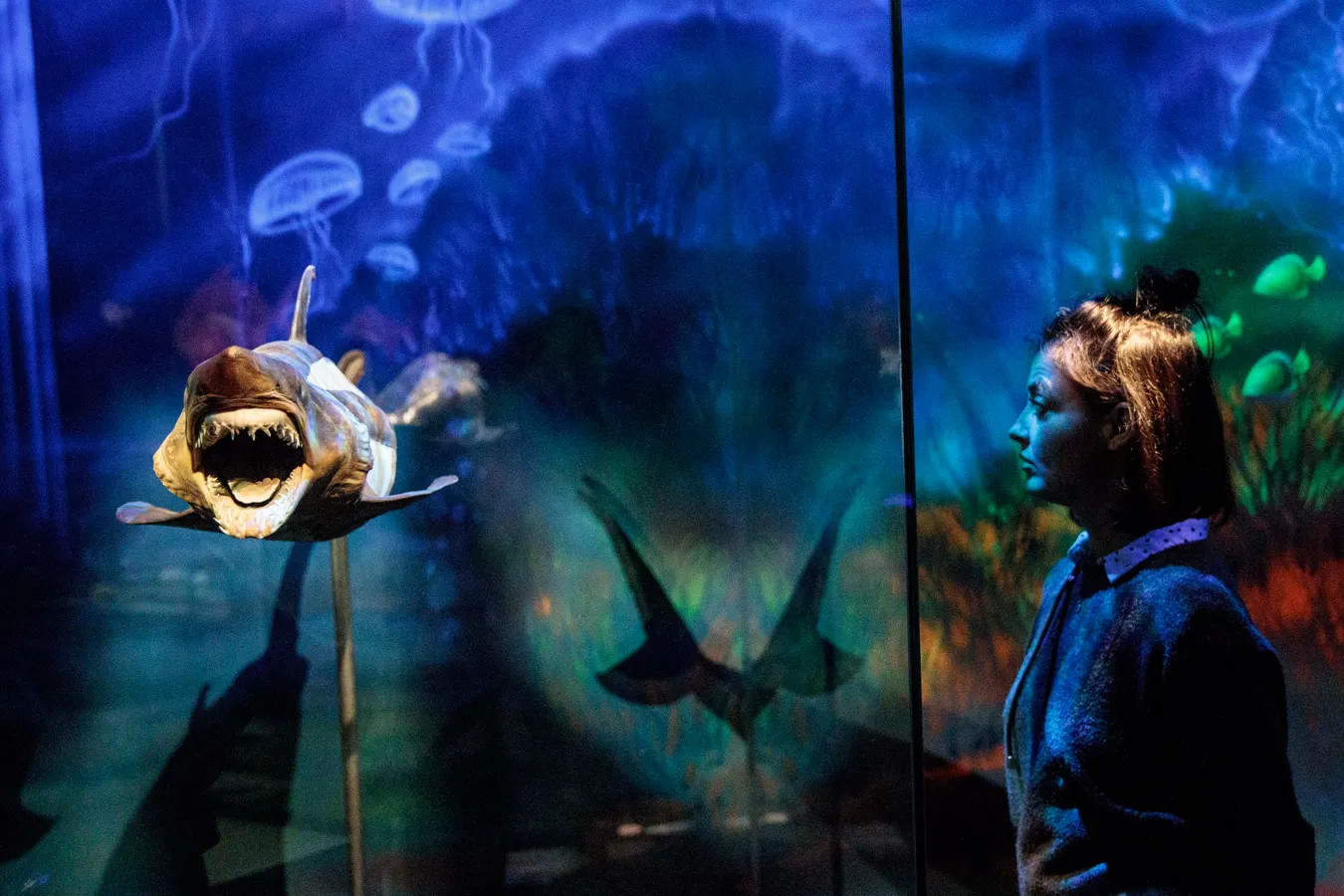Copyright forbes

28 February 2020, Berlin: A woman looks at an exhibited shark exhibit of the special exhibition of body worlds from the Museum of Man in SEA LIFE. Visitors are shown insights into the anatomy of sea creatures by means of underwater world exhibits. Photo: Carsten Koall/dpa (Photo by Carsten Koall/picture alliance via Getty Images) dpa/picture alliance via Getty Images Imagine standing on the edge of a misty mangrove at dawn, the water dark and still, knowing that beneath the surface there are numerous sharks gliding by you, silently. You have no cage, no bait and no chance to spot their dorsal fins. Instead, you dip a sterile bottle into the water and collect a few liters, each swirling drop carrying traces of DNA shed by the creatures in the ecosystem. Back in the lab, those microscopic fragments — think skin cells, mucus or scales — reveal the presence of those sharks and the countless other organisms sharing its habitat. Or perhaps you’re a land-based biologist, hiking a tropical rainforest at night, torchlight catching the glint of insects and leaves wet with rain. Somewhere in the underbrush, a rare frog that has not been seen for years crouches, perfectly camouflaged. Traditionally, spotting it would have required flushing it from its hiding place, risking stress or harm. Instead, you gently scoop water from a nearby puddle and filter it, knowing that the frog has left behind enough DNA in its environment to confirm its presence. Later, sequencing that environmental sample tells you not only that the frog exists here, but also which population it belongs to, information critical for its conservation. Environmental DNA, or eDNA, makes the invisible visible. Each genetic trace acts like a footprint, silently recording the movements and existence of life that would otherwise go unnoticed. It’s a way of reading the environment like a detective reading clues at a crime scene, except the crime is species disappearance, and the evidence is what the ecosystem has left behind. This new approach is transforming biodiversity science since traditional surveys often struggle to detect elusive, rare or cryptic species, and they can miss rapid ecological changes driven by climate change. eDNA, on the other hand, has proven capable of identifying everything from gobies hiding in murky estuaries to sharks cruising the open ocean. By bypassing the need for direct capture, it reduces the stress on species and saves time and resources. Yet the accuracy of this technology depends on something deceptively simple: whether we have enough genetic reference material to compare against. Without comprehensive DNA databases, the genetic signals recovered from water, soil or air risk being misidentified… or, worse, not identified at all. For centuries, museums have collected, cataloged and preserved specimens that document Earth’s biodiversity. Many of these samples were collected long before conservation biology even existed as a discipline. Inside drawers and jars sit not only common species but also rare, threatened and even extinct organisms! While originally gathered for morphological study (often the only physical record of life from a certain time and place), they now offer something more: a vast, underused genetic archive. But extracting DNA from these museum collections is not straightforward. Many specimens are old, dried or stored in formalin, which damages DNA. But advances in genomic techniques — what researchers call museomics — are making it possible to recover genetic information even from highly degraded material. Methods like next-generation sequencing, nested PCR and mini-barcodes allow scientists to reconstruct usable DNA sequences from samples collected decades or even centuries ago. In some cases, entire mitochondrial genomes, which are especially valuable for eDNA studies, can be recovered! The importance of this for eDNA research cannot be overstated. Current databases lean heavily on certain markers, like the COI gene, which works well for some animals but not all. Fish, for example, are often better identified using 12S or 16S markers, but these are still underrepresented in public databases. By sequencing specimens from museum collections, researchers can fill these gaps, linking DNA sequences directly to vouchered specimens that have been carefully identified by taxonomists. It boosts accuracy, sure, but it also prevents errors from propagating across studies. And museum collections also capture genetic diversity within species! A species of fish, for example, might have multiple museum samples collected across its geographic range and sequencing these specimens means databases can reflect intraspecific variation, making it easier to distinguish local populations in eDNA surveys. This matters for conservation, since protecting genetic diversity is just as important as protecting species themselves. MORE FOR YOU A researcher gathers a jar containing a shark specimen. (Photo by Chris Young - PA Images/PA Images via Getty Images) PA Images via Getty Images The same principle applies to sharks! Among the most elusive and hard-to-study marine animals, many species spend most of their lives in deep or offshore waters, are highly migratory, and often occur at low densities. Traditional monitoring (i.e., tagging, visual surveys or fishing) can be expensive, logistically challenging and sometimes harmful to the animals. But with eDNA, a few liters of seawater taken from a reef or along a migration route can reveal which shark species are present, including rare or threatened species that might otherwise go undetected. However, eDNA works only if we can correctly identify the sequences recovered and that’s where comprehensive reference databases come in (currently, some shark species are poorly represented in these genetic libraries). By sequencing DNA from museum specimens — including historical type specimens — researchers can fill gaps, linking sequences to verified species and capturing genetic variation across populations. This allows scientists to map shark distributions more accurately and monitor changes over time. For their conservation, this is a game-changer. With eDNA informed by museum-based reference databases, scientists can detect shifts in shark populations caused by overfishing, climate change or habitat loss before these declines become catastrophic. They can identify hotspots where sharks congregate, uncover previously unknown populations and even track the spread of invasive species or hybrids. In a way, the technology turns the oceans into a living archive of shark presence, while museum collections provide the genetic keys to read it. Of course, there are challenges. Historical specimens sometimes suffer from contamination, both from the preservation process and from centuries of handling. Mislabeling or outdated taxonomy can also create confusion with individual specimens. That is why Dr. Sarah Schmid and a team of researchers recently published a paper that outlines considerations regarding the use of museum specimens to minimize errors, like suggesting that specimens be carefully reexamined by experts before sequencing and metadata — like where and when the specimen was collected — be verified. Ethical considerations are also essential, as many museum collections include specimens collected during colonial periods (often without the consent or participation of local communities). Modern efforts, the team suggest, should ensure that countries of origin benefit from any and all genetic research, whether through collaboration, access to data or shared recognition. Yet, despite these challenges, the potential is enormous. Climate change is shifting species distributions at an unprecedented pace. Coral reefs, forests, wetlands and deep-sea ecosystems are all undergoing rapid transformation, often faster than we can monitor them. eDNA offers a way to keep up, but it only works if we know what we’re looking at. Projects like the Earth BioGenome Project and the Vertebrate Genomes Project are already sequencing whole genomes of many species, and existing museum collections will allow us to extend this work to rare or extinct organisms that would otherwise be missing from the record. It’s a win-win, with this strengthening conservation, enabling us to detect invasive species earlier, protect threatened ones more effectively and track biodiversity changes with greater precision. In the end, eDNA and museums are two sides of the same coin. One captures the living traces of the present, the other preserves the biological legacy of the past. Together, they hold the key to understanding Earth’s biodiversity in a time of rapid change. The challenge to make this work is immense, but so is the opportunity. To see, with unprecedented clarity, the living fabric of our planet before it unravels further… that’s priceless. Editorial StandardsReprints & Permissions



